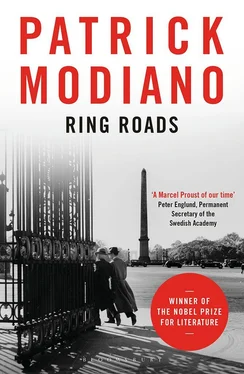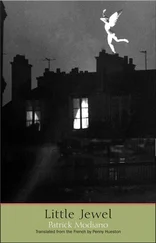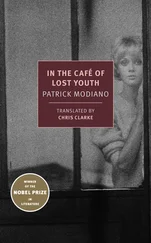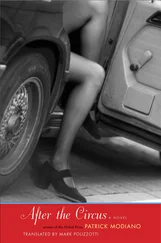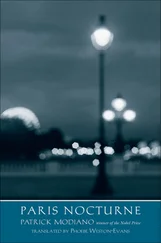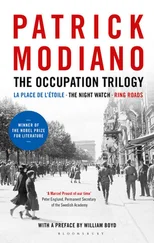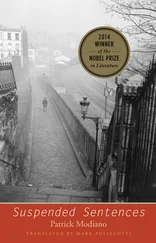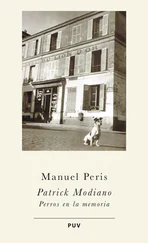Patrick Modiano - Ring Roads
Здесь есть возможность читать онлайн «Patrick Modiano - Ring Roads» весь текст электронной книги совершенно бесплатно (целиком полную версию без сокращений). В некоторых случаях можно слушать аудио, скачать через торрент в формате fb2 и присутствует краткое содержание. Год выпуска: 2015, Издательство: Bloomsbury Paperbacks, Жанр: Современная проза, на английском языке. Описание произведения, (предисловие) а так же отзывы посетителей доступны на портале библиотеки ЛибКат.
- Название:Ring Roads
- Автор:
- Издательство:Bloomsbury Paperbacks
- Жанр:
- Год:2015
- ISBN:нет данных
- Рейтинг книги:3 / 5. Голосов: 1
-
Избранное:Добавить в избранное
- Отзывы:
-
Ваша оценка:
- 60
- 1
- 2
- 3
- 4
- 5
Ring Roads: краткое содержание, описание и аннотация
Предлагаем к чтению аннотацию, описание, краткое содержание или предисловие (зависит от того, что написал сам автор книги «Ring Roads»). Если вы не нашли необходимую информацию о книге — напишите в комментариях, мы постараемся отыскать её.
The Night Watch
Ring Roads — читать онлайн бесплатно полную книгу (весь текст) целиком
Ниже представлен текст книги, разбитый по страницам. Система сохранения места последней прочитанной страницы, позволяет с удобством читать онлайн бесплатно книгу «Ring Roads», без необходимости каждый раз заново искать на чём Вы остановились. Поставьте закладку, и сможете в любой момент перейти на страницу, на которой закончили чтение.
Интервал:
Закладка:
He stops, pushes open the gate of the ‘Priory’, a strange villa in the neo-Romanesque style. Before going in, he hesitates for a moment. Does the house belong to him? Since when? He shuts the gate behind him, slowly crosses the lawn to the steps leading to the house. His back is bowed. He looks so sad, this overweight man shuffling through the darkness. .
Certainly one of the prettiest and most idyllically situated villages in Seine-et-Marne. On the outskirts of the Forest of Fontainebleau. A few Parisians have country houses here, but they are no longer around, probably ‘because of the worrying turn of events’.
Monsieur and Madame Beausire, the owners of the Clos-Foucré inn, left last year. They said they were going for a change of air to their cousins’ place in Loire-Atlantique, but everyone realised that if they were taking a holiday, it was because regular customers were increasingly scarce. Which makes it difficult to understand why a woman from Paris has taken charge of the Clos-Foucré. Two men — also from Paris — have bought Mme Lamiroux’s house at the edge of the forest. (It has stood empty for nearly ten years.) The younger of the two — apparently — had served in the Foreign Legion. The other was the editor of a Paris newspaper. One of their friends had moved into the ‘Priory’, the Guyots’ country-house. Is he renting it? Or is he taking advantage of the family’s absence? (The Guyots have settled in Switzerland for an indefinite period.) He’s a chubby rather oriental looking man. He and his two friends obviously have very large incomes but they seem to have acquired their money fairly recently. They spend the weekend here, as middle-class families did in happier times. On Friday evening, they come down from Paris. The one who was in the Legion roars down the High Street behind the wheel of a beige Talbot and screeches to a halt in front of the Clos-Foucré. A few minutes later, the other’s saloon is also parked up at the auberge . They usually have guests with them. The red-haired woman who always wears jodhpurs, for instance. On Saturday mornings, she goes riding in the forest and when she gets back to the stables, the grooms hover round her and take particular care of her horse. In the afternoon, she walks along the main road followed by an Irish setter whose russet coat (is it deliberate?) matches her tan boots and her red hair. Very often she is accompanied by a young woman with blonde hair — the daughter, apparently, of the magazine editor. This one always wears a fur coat. The two women call in for a minute at Mme Blairiaux’s antique shop and choose some jewellery. The red-haired woman once bought a large Louis XV lacquer cabinet that Mme Blairiaux had despaired of selling because it was so expensive. When she realized her customer was offering her two million francs in cash, she looked scared. The red-haired woman put the wad of banknotes on a whatnot. Later a van collected the cabinet and delivered it to Mme Lamiroux’s house (since they have been occupying it, the magazine editor and the ex-Legionary have christened it the ‘Villa Mektoub’.) This same van has been seen taking objets d’art and paintings, the red-haired woman’s haul from local auctions, regularly up to the ‘Villa Mektoub’; on Saturday evenings, she arrives back from Melun or Fontainebleau in the car with the magazine editor. The van follows, loaded with every kind of bric-a-brac: rustic furniture, china, chandeliers, silver, which are all cached at the villa. Gossip among the villagers is rife. They would dearly like to know more about the red-haired woman. She is staying at the Clos-Foucré, not at the ‘Villa Mektoub’. But you can tell that there’s a close relationship between her and the editor. Is she his mistress? A friend? There are rumours the ex-Legionary is a count. And that the heavyset gentleman at the ‘Priory’ calls himself ‘Baron’ Deyckecaire. Are their titles genuine? Neither is exactly what one thinks of as a genuine aristocrat. There’s something odd about them. Perhaps they are foreign noblemen? Wasn’t ‘Baron’ Deyckecaire overheard one day saying to the editor in a loud voice: ‘That doesn’t matter, I’m a Turkish citizen!’ And the ‘Count’ speaks French with a slight working-class accent. Picked up in the Legion? The red-haired woman seems to be something of an exhibitionist, why else does she wear so much jewellery, which is so out of keeping with her riding clothes? As for the young blonde woman, it’s odd that she wraps herself up in a fur coat in June. The country air must be too much for her. She had her photograph in Ciné-Miroir . The caption read: ‘Annie Murraille, 26, star of Nights of Plunder .’ Is she still an actress? She often goes walking arm in arm with the ex-Legionary, with her head on his shoulder. They must be engaged.
Other people arrive on Saturdays and Sundays. The editor often invites as many as twenty guests. You get to know most of them in due course, but it’s difficult to put a name to each face. Bizarre rumours are widespread in the village. That the editor organizes a ‘special’ kind of party at the ‘Villa Mektoub’ which was why ‘all these strange characters’ come down from Paris. The woman running the Clos-Foucré while the Beausires once ran a bordello. In fact, the Clos-Foucré was beginning to seem more like a brothel, given the curious clientele now staying there. People wondered, what underhand means had ‘Baron’ Deyckecaire used to get his hands on the ‘Priory’? The man looked like a spy. The ‘Count’ had probably joined the Foreign Legion to avoid being prosecuted for some crime. The editor and the red-haired woman were engaged in nefarious trafficking of some sort. There were orgies being held up at the ‘Villa Mektoub’, and the editor even got his niece to take part. He was more than happy to push her into the arms of the ‘Count’ and anyone else whose silence he wanted to buy. In short, the locals ended up convinced that their village had been ‘overrun by a mob of gangsters’. A reliable witness, as they say in novels and police reports, looking at the editor and his entourage, would immediately think of the ‘crowd’ who frequent certain bars on the Champs-Élysées. Here, they are completely out of place. On evenings when there is a crowd of them, they have dinner at the Clos-Foucré, then straggle up to the ‘Villa Mektoub’ in small groups. The women are all red-heads or platinum blondes, the men all wear brash suits. The ‘Count’ leads the way, his arm wound in a white silk scarf as if he had just been wounded in action. To remind him of his days in the Legion? They clearly play their music loud since blasts of rumba, hot jazz and snatches of song can be heard from the main road. If you stop near the villa, you can see them dancing behind the French windows.
One night, at about 2 a.m., a shrill voice screamed ‘Bastard!’. The red-haired woman came running out of the villa with her breasts spilling out of her décolleté. Someone rushed after her. ‘Bastard!’ she shrieked again, then she burst out laughing. In the early days, the villagers would open their shutters. Then they got used to the racket the newcomers made. Now, no-one is surprised by anything.
The magazine was obviously launched recently, since the current issue is number 57. The name — C’est la vie — is emblazoned in black-and-white letters. On the cover, a woman in a suggestive pose. You would think it was a pin-up magazine were it not that the slogan — ‘A political and society weekly’ — didn’t claim more high-flying aspirations.
On the title page, the name of the editor: Jean Murraille. Then, under the heading: features, the list of about a dozen contributors, all unknown. Try as you might, you can’t remember seeing their names anywhere. At a pinch, two names vaguely ring a bell, Jean Drault and Mouly de Melun: the former, a pre-war columnist, the author of Soldat Chapuzot ; the latter a starving writer for Illustration . But the others? What to the mysterious Jo-Germain, the author of the cover story about ‘Spring and Renewal’? Written in fancy French, and ending with the injunction: ‘Be joyful!’ The article is illustrated by several photographs of young people in extremely informal dress.
Читать дальшеИнтервал:
Закладка:
Похожие книги на «Ring Roads»
Представляем Вашему вниманию похожие книги на «Ring Roads» списком для выбора. Мы отобрали схожую по названию и смыслу литературу в надежде предоставить читателям больше вариантов отыскать новые, интересные, ещё непрочитанные произведения.
Обсуждение, отзывы о книге «Ring Roads» и просто собственные мнения читателей. Оставьте ваши комментарии, напишите, что Вы думаете о произведении, его смысле или главных героях. Укажите что конкретно понравилось, а что нет, и почему Вы так считаете.
